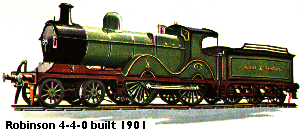


Accidents

Currents

Features

Gallery

Books

Links

Site Map

Help

Search

Bibliography

Glossary



Summary
 Aylesbury, 1904, Great Central Railway. The 0248 express from Marylebone Station became derailed at Aylesbury having failed to slow down in time to take a curve over a trailing junction. Another train, travelling in the opposite direction struck the wreckage. Massive destruction of rolling stock followed and four people were killed.
Aylesbury, 1904, Great Central Railway. The 0248 express from Marylebone Station became derailed at Aylesbury having failed to slow down in time to take a curve over a trailing junction. Another train, travelling in the opposite direction struck the wreckage. Massive destruction of rolling stock followed and four people were killed.
 The Great Central Railway's main line left London from its terminus at Marylebone and joined the Metropolitan Railway in a joint undertaking as the Metropolitan & Great Central Joint railway. From Wendover there is a seven mile (12Km) falling grade with a ruling gradient of 1 in 117. A stretch of line that made for easy work for a steam hauled express train. At Aylesbury, there is a curve where the line from Princes Risborough joins the main-line. Careful negotiation of this combination of curve and trailing junction is required, necessitating moderate speed.
The Great Central Railway's main line left London from its terminus at Marylebone and joined the Metropolitan Railway in a joint undertaking as the Metropolitan & Great Central Joint railway. From Wendover there is a seven mile (12Km) falling grade with a ruling gradient of 1 in 117. A stretch of line that made for easy work for a steam hauled express train. At Aylesbury, there is a curve where the line from Princes Risborough joins the main-line. Careful negotiation of this combination of curve and trailing junction is required, necessitating moderate speed. The 0248 Express from Marylebone was headed by No. 1040, a 4-4-0 designed by Robinson, and consisted of its usual compliment of a mixture of parcels vans and passenger vehicles. The train, commencing at that hour of the morning was run primarily for the carriage of newspapers and parcels. Few passengers were expected to make use of the service and therefore only three coaches were included. Indeed only eight passengers were being conveyed that night.
 There was dense fog on the bank from Wendover, but this did not impede the progress of 1040. The driver was making good time and had reached a speed of 60 mph (100 Km/h). Perhaps the driver had become "lost" because of the darkness and the fog. The usual landmarks thereby obscured may have made it difficult for him to be certain of where he was or indeed to judge his speed accurately. But what ever the reason, at 0338 that morning the train approached the junction with no slackening of pace and with no hope of ridng the curve safely. The train left the rails. The locomotive continued up onto the down platform taking the first three coaches with it. Two more finished their journey on the up platform. The wooden bodied carriages splintered and wreckage was strewn across both lines. Onto this scene came the Manchester-Marylebone express, it too headed by a Robinson 4-4-0, number 1042. Fortunately, this train had slowed in preparation for the curve and by making an application of his brakes the driver was able to bring his train to rest with only a slight collision with the wreckage.
There was dense fog on the bank from Wendover, but this did not impede the progress of 1040. The driver was making good time and had reached a speed of 60 mph (100 Km/h). Perhaps the driver had become "lost" because of the darkness and the fog. The usual landmarks thereby obscured may have made it difficult for him to be certain of where he was or indeed to judge his speed accurately. But what ever the reason, at 0338 that morning the train approached the junction with no slackening of pace and with no hope of ridng the curve safely. The train left the rails. The locomotive continued up onto the down platform taking the first three coaches with it. Two more finished their journey on the up platform. The wooden bodied carriages splintered and wreckage was strewn across both lines. Onto this scene came the Manchester-Marylebone express, it too headed by a Robinson 4-4-0, number 1042. Fortunately, this train had slowed in preparation for the curve and by making an application of his brakes the driver was able to bring his train to rest with only a slight collision with the wreckage.Both the driver and the fireman of 1040 were killed. Two passengers, who happened to be railway employes also died.
At the subsequent enquiry, the inspecting officer, Lt Col Yorke commented that the accident was one of the worst cases of the destruction of rolling stock in a derailment that he had ever known.
 Top
Top
 Contents | Index of Articles | Recent Reports | Post Office | Links | Site Map | Guestbook | E-mail
Contents | Index of Articles | Recent Reports | Post Office | Links | Site Map | Guestbook | E-mail


